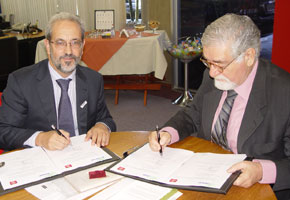

Daniel Hernández Ruipérez, Rector of USAL (left) and FAPESP President Celso Lafer sign the cooperative agreement between the institutions
Daniel Hernández Ruipérez, Rector of USAL (left) and FAPESP President Celso Lafer sign the cooperative agreement between the institutions
Daniel Hernández Ruipérez, Rector of USAL (left) and FAPESP President Celso Lafer sign the cooperative agreement between the institutions

Daniel Hernández Ruipérez, Rector of USAL (left) and FAPESP President Celso Lafer sign the cooperative agreement between the institutions
By Elton Alisson
Agência FAPESP –FAPESP and Spain’s Universidade de Salamanca (USAL) signed a scientific cooperation agreement for the development of research projects between researchers and post-graduate students in Brazil and the Iberian nation.
The agreement will be implemented through the Brazilian Studies Center (CEB), headquartered at the Spanish university. Created in 2000, the center’s role is to foment scientific and cultural cooperation between researchers and intellectuals from Brazil and Spain.
The Hispanic-Brazilian Cultural Foundation was established in 2001 to support the activities of the CEB. The Honorary President of the Foundation is King of Spain Juan Carlos.
“The Brazilian Studies Center works not only with the Universidade de Salamanca, but also with other universities in Spain. This way, any program carried out together with FAPESP will be able to count on the participation of researchers of international renown not only from the Universidade de Salamanca but also from other universities and research institutions in Spain and Europe,” CEB director Gonzalo Gómez Dacal told Agência FAPESP.
One of the objectives of the agreement with FAPESP is to conduct joint research in fields considered to be at the frontier of science. Other areas of focus are literature and cancer research, for which USAL has a world-famous research center, and fields in which Brazil is strong, such as energy and agriculture.
“Brazil and Spain’s scientific relationship is quite well-balanced. The number of patents, publications in periodicals and doctoral theses from the two nations is very similar and makes for a strong cooperative process,” said Dacal.
The CEB is expected to sponsor a symposium in 2012 on the pioneering fields in which Brazil and Spain are strongest. In November, USAL will hold the Ibero-American Science and Technology Fair (Empirika) at the Universidade Estadual de Campinas (Unicamp).
This will be the first time that the annual fair will not be held on Spanish soil. After Brazil, the event will travel to other nations, including Mexico. It will return to USAL in 2018, when the Spanish university, one of the world’s oldest, will celebrate its 800th birthday.
“The Universidade de Salamanca has much interest in gaining presence in Brazil, communicating and working with Brazilian researchers and intellectuals that are outstanding in their fields,” said Dacal.
The agreement between the university and FAPESP was signed by the Foundation’s president, Celso Lafer, and by USAL’s rector, Daniel Hernández Ruipérez. Ruipérez was accompanied by Dacal and Noemí Domínguez García, vice-rector of international institutional relations for USAL.
Also representing FAPESP at the meeting were Douglas Eduardo Zampieri, member of the adjunct committee on Research Collaboration and the committee on Research for Innovation, and Fernando Dias Menezes de Almeida, advisor to the president.
During the meeting, Lafer emphasized the importance of scientific cooperation agreements like the one between FAPESP and the Universidade de Salamanca.
“This agreement reflects FAPESP’s policy and concern regarding the internationalization of science and the interaction between Brazilian researchers and those from the rest of the world, including Iberia,” Lafer declared.
Read more at www.fapesp.br/acordos-salamanca
Republish
The Agency FAPESP licenses news via Creative Commons (CC-BY-NC-ND) so that they can be republished free of charge and in a simple way by other digital or printed vehicles. Agência FAPESP must be credited as the source of the content being republished and the name of the reporter (if any) must be attributed. Using the HMTL button below allows compliance with these rules, detailed in Digital Republishing Policy FAPESP.





